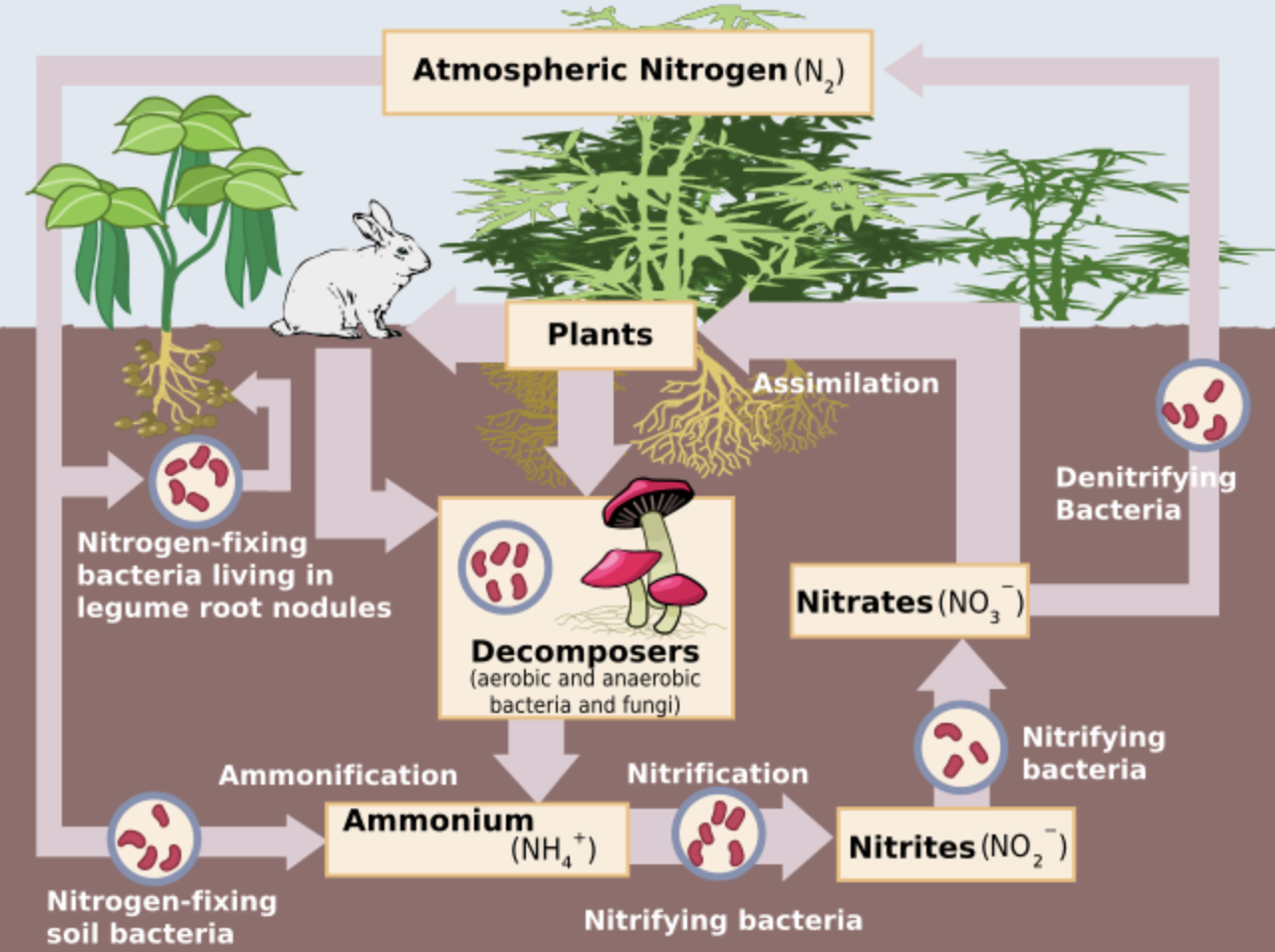
Bacteria which convert atmospheric nitrogen into nitrogen compounds are called
(a) Nitrogen-fixing bacteria
(b) Nitrifying bacteria
(c) Putrefying bacteria
(d) Denitrifying bacteria
Answer
473.7k+ views
Hint: Only prokaryotic organisms can reduce atmospheric ${ N }_{ 2 }$ to ammonia because they have an enzyme known as nitrogenase which is found exclusively in them. There are many bacteria that reduce nitrogen found in soil as free forms or as symbionts.
Complete Step by Step Answer:
The process of conversion of nitrogen ${ N }_{ 2 }$ present in the air to ammonia is known as nitrogen fixation. The bacteria which convert atmospheric nitrogen into nitrogen compounds are known as nitrogen-fixing bacteria. Dead plants and animals can be converted into ammonia by the process of decomposition then it will be known as ammonification.

So, the correct option is ‘Nitrogen- fixing bacteria’.
Additional information:
Let us learn more about the type and examples of biological nitrogen fixers.
- Free-living nitrogen fixers: These are free-living and fix nitrogen in the soil because they are chemoautotrophs which means they derive energy by breaking or oxidizing chemical compounds.
- Aerobic bacteria: Azotobacter, Beijerinckia, Anabaena, Nostoc
- Anaerobic bacteria: Rhodospirillum
- Symbiotic nitrogen fixers: The best example of symbiotic nitrogen fixation is the legume- bacteria relationship. Rod-shaped Rhizobium lives in a symbiotic relationship with many leguminous plants such as alfalfa, sweet clover, sweet pea, lentils, etc. This association is found in the form of nodules which are small outgrowths.
Frankia performs nitrogen fixation by having a symbiotic relationship with non- leguminous plants such as Alnus.
Note:
- Both Rhizobium and Frankia are seen as free- living in soil but when found as symbionts they fix nitrogen in exchange for food and nutrients.
- The process of oxidation of ammonia to nitrite and then nitration is known as nitrification and is done by bacteria such as Nitrosomonas and Nitrobacter respectively.
- Some bacteria also convert the ammonia in the soil back to atmospheric nitrogen and this process is called denitrification and is carried out by Pseudomonas and Thiobacillus.
Complete Step by Step Answer:
The process of conversion of nitrogen ${ N }_{ 2 }$ present in the air to ammonia is known as nitrogen fixation. The bacteria which convert atmospheric nitrogen into nitrogen compounds are known as nitrogen-fixing bacteria. Dead plants and animals can be converted into ammonia by the process of decomposition then it will be known as ammonification.

So, the correct option is ‘Nitrogen- fixing bacteria’.
Additional information:
Let us learn more about the type and examples of biological nitrogen fixers.
- Free-living nitrogen fixers: These are free-living and fix nitrogen in the soil because they are chemoautotrophs which means they derive energy by breaking or oxidizing chemical compounds.
- Aerobic bacteria: Azotobacter, Beijerinckia, Anabaena, Nostoc
- Anaerobic bacteria: Rhodospirillum
- Symbiotic nitrogen fixers: The best example of symbiotic nitrogen fixation is the legume- bacteria relationship. Rod-shaped Rhizobium lives in a symbiotic relationship with many leguminous plants such as alfalfa, sweet clover, sweet pea, lentils, etc. This association is found in the form of nodules which are small outgrowths.
Frankia performs nitrogen fixation by having a symbiotic relationship with non- leguminous plants such as Alnus.
Note:
- Both Rhizobium and Frankia are seen as free- living in soil but when found as symbionts they fix nitrogen in exchange for food and nutrients.
- The process of oxidation of ammonia to nitrite and then nitration is known as nitrification and is done by bacteria such as Nitrosomonas and Nitrobacter respectively.
- Some bacteria also convert the ammonia in the soil back to atmospheric nitrogen and this process is called denitrification and is carried out by Pseudomonas and Thiobacillus.
Recently Updated Pages
Master Class 11 Accountancy: Engaging Questions & Answers for Success

Glucose when reduced with HI and red Phosphorus gives class 11 chemistry CBSE

The highest possible oxidation states of Uranium and class 11 chemistry CBSE

Find the value of x if the mode of the following data class 11 maths CBSE

Which of the following can be used in the Friedel Crafts class 11 chemistry CBSE

A sphere of mass 40 kg is attracted by a second sphere class 11 physics CBSE

Trending doubts
10 examples of friction in our daily life

Difference Between Prokaryotic Cells and Eukaryotic Cells

State and prove Bernoullis theorem class 11 physics CBSE

What organs are located on the left side of your body class 11 biology CBSE

Define least count of vernier callipers How do you class 11 physics CBSE

The combining capacity of an element is known as i class 11 chemistry CBSE




